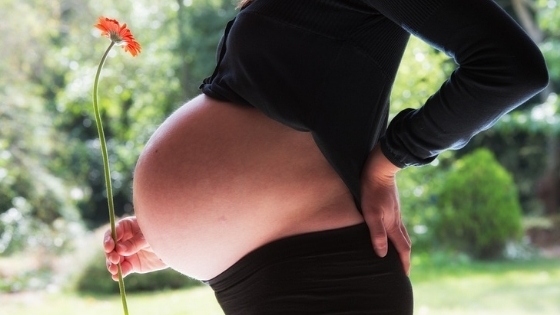Pregnancy is an amazing and exciting time for women, a new life is developing and there are so many incredible milestones to look forward to such as your baby’s first kick and when your baby bump starts being visible.
Along with all these amazing things comes some not so great side effects of pregnancy such as morning sickness, pelvic pain, back pain and sore breasts. However many of these pregnancy symptoms disappear the moment your baby appears. Unfortunately there will also be some changes to your body that are not very welcome and that may take a while to remedy and sometimes they may even be there to stay.
Stretch marks is a very common occurrence during and after pregnancy.

What Causes Pregnancy Stretch Marks
During pregnancy your skin is going to stretch as you put on weight and your body changes. Stretch marks are in fact very small tears in the supporting tissue (elastin and collagen) that is under your skin, these tears occur due to your skin being pulled so tight. You can read more about elastin at Perimeter Institute.
Whether you will get stretch marks or not depends on a number of factors including skin color (stretch marks are more common with light skin and more noticeable), genetics (whether your mother got stretch marks), whether you are having one baby or multiples, how rapidly you gain weight and whether you have excess amniotic fluid or not.
Depending on your skin color, stretch marks can be pink, reddish brown, dark brown or purple. After your baby is born your stretch marks will fade, but chances are they will never completely go away.
Stretch marks can appear on the lower abdomen, hips, thighs, breasts and/or buttocks.
How To Prevent Pregnancy Stretch Marks
You can check any website and you will find that stretch marks are inevitable during and after pregnancy, however there are a few things you can do during pregnancy that can help to keep stretch marks to a minimum:
- Keep your skin moisturised – make sure to rub cream into your skin every day. This won’t completely prevent stretch marks but it will help to keep your skin in a good condition. It will also help with dry, itchy skin that often occurs during pregnancy. Be careful to check any creams that you use while pregnant and breastfeeding to ensure it is safe for your baby – everything absorbed into your body can be passed to your baby. You can go for natural ways to moisturise your skin such as olive oil or coconut oil.
- Exercise regularly – you need to exercise during pregnancy to keep yourself fit and in shape anyway, however an added bonus is that exercise can help to reduce stretch marks. Exercise will improve your circulation and help your skin to keep its elasticity.
- Drink plenty of water – keeping your skin hydrated is not just about putting lotion on the outside, you need to moisturise from the inside too!
- Eat healthily – the things you eat impact your health, including the health of your skin. Make sure to research what you should be eating during pregnancy and stick to a healthy eating plan for pregnancy. Foods that are good for your skin include foods rich in fatty acids such as Omega 3, zinc, antioxidants, vitamins and minerals.
- Manage your weight – one of the biggest causes is putting on too much weight too quickly, through exercise, drinking water and eating well you should be able to manage you weight well.
- Vitamin D – studies have shown that there is a link between not getting in enough Vitamin D and stretch marks. Make sure to focus on getting in foods that are rich in Vitamin D and spend some time in the sun since this is the best way to get Vitamin D into you body. Be careful not to stay in the sun too long or let yourself get sun burnt.

How To Remedy Stretch Marks
Even with taking all those preventative measure mentioned above you may find yourself with unsightly stretch marks after giving birth to your baby. It is important to remember that no matter how bad your stretch marks look immediately after birth they will fade with time.
Give it time. Your stretch marks took 9 months to appear and they will take some time to start fading too. Be patient and gently with yourself and try to focus on the miracle of your beautiful baby in the first few months.
Here are some ways to treat your stretch marks after birth:
- Massage your body with oil or lotion – there are plenty of oils and lotions for stretch marks (see the list below for some great options) which you can try out. Find one that you like and enjoy, then spend some time every day massaging it into your skin. Massage comes with many benefits, including improving your blood circulation which will help your skin to repair itself as well as to break up the scar tissue that has formed. Massaging your problem areas will be one of the best things you can do for your stretch marks.
- Keep your skin moisturised – make sure to focus on massaging and moisturising regularly. Keeping your skin moisturised will help to keep it healthy, bright and smooth. Skin that is hydrated will have better elasticity and be better able to maintain its outer protective layer.
- Exercise will help you to lose weight, to tone your body and to build up your muscles after having your baby. When your muscles are strengthened this will help to tighten your loose skin over those areas and to encourage faster healing.
- Exfoliating regularly will remove the dead skin cells and help your skin to heal and repair itself, while promoting growth in the deeper layer of the skin which is where the stretch marks are formed.
 Kaboutjie SA Mommy Blogs by Lynne Huysamen
Kaboutjie SA Mommy Blogs by Lynne Huysamen




